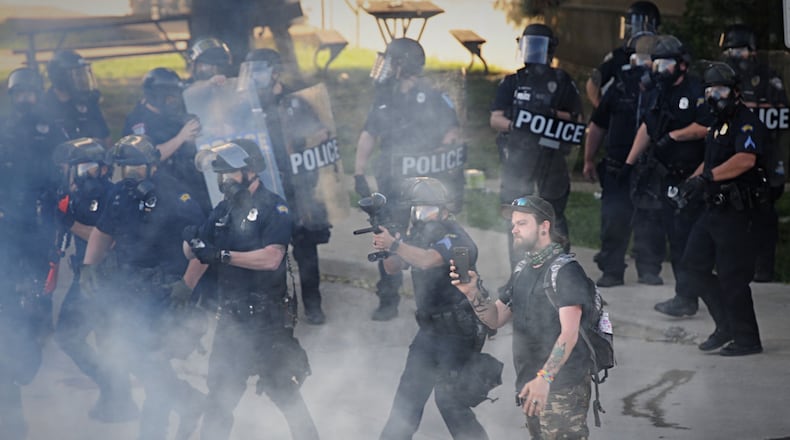Dayton police say the overwhelming majority of encounters between officers and citizens are peaceful and do not escalate.
“Even in circumstances where officers encounter obstruction, resistance or are assaulted, uses of force occur in a minority of those incidents,” said Dayton police Lt. Eric Sheldon, commander of the Professional Standards Bureau, which was formerly internal affairs.
Some community members and leaders say they hope ongoing police reform efforts will reduce the number of police-citizen interactions that result in officers using force like tasers, strikes, chemical agents and “less lethal” munitions.
“As I reviewed the use-of-force annual report, it showed some progress being made with the decline of use-of-force incidents, but also in the same token it shows how much more work needs to be done to prevent escalation between an officer and a civilian,” said Willis Blackshear Jr., who was co-lead of a police reform committee focused on use of force.
Dayton police recorded using force in 169 times in 2020, which was 29 fewer incidents than in 2019, or a 15% decline, according to Professional Standards Bureau data.
Police data show that officers used force against more than 169 people, because some incidents involved use of force against more than one person. Also, multiple types of force could be used during the same incident (one case could include both a knee strike and a Taser).
The number of police incidents involving use of force had increased for multiple years before 2020.
The police department only had data going back four years. Officials said the department has a four-year record retention period, and data is purged after that.
In 2020, Dayton police used force against 49 white men, 10 white females and eight Black women, police department data show. Compared to 2019, use-of-force incidents involving white men decreased 36%; incidents involving Black women declined 43%; and incidents involving white women remained unchanged.
But Dayton police used force against 100 Black men in 2020 — which was three more than in 2019.
Crime declines
Overall, crime declined in Dayton in 2020, which some police officials have said could be partly related to coronavirus-related restrictions and stay-at-home orders that disrupted many people’s normal activities and routines.
Fewer people went out, meaning there were fewer opportunities for conflict, especially during late-night hours when bars, restaurants and streets that normally might be packed were empty or shut down.
Police that year responded to 3% fewer calls for service and “self-initiated” incidents, compared to 2019.
Police also received more critical attention in the spring and summer of 2020 after George Floyd was killed by police in Minneapolis.
Protests erupted in Dayton and many other cities across the nation, and many demonstrators decried what they said was law enforcement’s aggressive tactics.
Some protestors also criticized Dayton police and other local law enforcement agencies for using force like pepper balls and bean bag rounds during protests in and around downtown Dayton.
The local protests led then-Dayton Mayor Nan Whaley to create five police reform committees to develop recommendations for changes to police practices, policies and procedures.
Community members and police officials involved in the reform efforts generally agreed that it is in the best interest of officers, citizens and police-community relations to try to find ways to avoid situations where conflict escalates and officers resort to force.
Annual report
Lt. Sheldon said Dayton police each year use force in a very small fraction of encounters with citizens.
Officers responded to 137,051 calls for service and self-initiated incidents in 2020, and force was used in about 0.12% of those encounters, according to department data.
Dayton police also used counter force about 172 times in 2020, which was a 16% reduction from 2019.
Counter force is deployed when officers are assaulted by citizens or citizens resist arrest or fail to comply with an order of an officer, police said, and there were 822 of these incidents in 2020.
Police officials also said Dayton officers arrested fewer people in 2020 and there were significantly fewer administrative investigations.
The police reform committee focused on use of force issued a recommendation to require the police department to help produce an annual use-of-report report to the city commission.
One of the report’s primary goals is to try to identify potential patterns or areas of concern that need addressed, committee members said.
Sharing use-of-force statistics promotes police transparency, which help builds trust with the community, and it also helps identify areas in need of improvement, said Blackshear, co-leader of the use-of-force reform committee and a member of the Ohio House.
“I hope these stats will be used in a way to help improve with the training of officers when they are in contact with people in the community, and how to de-escalate a situation,” he said.
Dayton Mayor Jeff Mims Jr., who also was co-lead of the use-of-force reform committee, said he hopes to see the number of use-of-force incidents continue to decline.
Mims said he hopes the thoughtful use-of-force policy changes recommended by his reform committee will help improve interactions between police and citizens.
He said the use-of-force report is a valuable tool.
“Being able to look at the numbers and ask questions will help us to identify trends and our ability to better understand them,” he said.
Other members of the use-of-force reform committee did not return requests for comment last week.
About the Author




